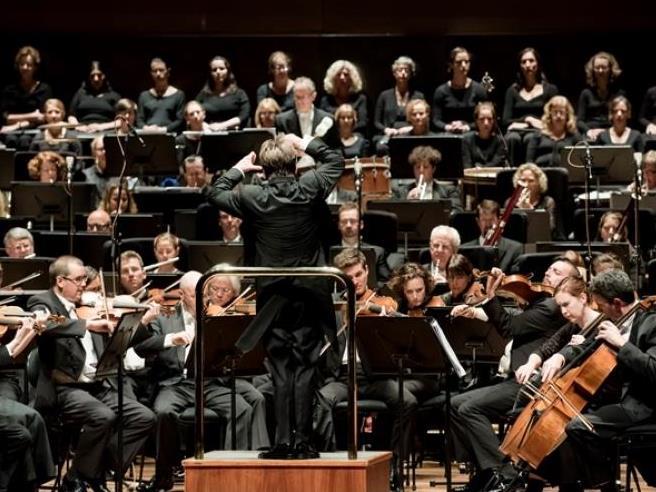The MSO performs Mahler 7, conducted by Sir Andrew Davis. Photo by Daniel Aulsebrook via MSO.
Since its first performance in Prague in 1908, Mahler’s seventh Symphony has sometimes been unfairly regarded as the most problematic of his ten symphonies and the least appreciated by performers and listeners. In this program the 80-minute-long symphonic colossus was paired with Australian composer Paul Stanhope’s comparatively straightforward The Heaven’s Declare, a choral symphony for large chorus and orchestra commissioned by Sydney Philharmonia Choirs in 1999 and reorchestrated last year.
Stanhope’s work, inspired from gazing at a canopy of stars while camping on Fraser Island, sets Old Testament texts in Latin translation. The work was competently structured, carefully orchestrated and sensitively performed by the MSO Chorus (carefully prepared by guest chorus master Warren Trevelyan-Jones) and the MSO under its chief conductor, Andrew Davis. A work clearly cut out to be a crowd pleaser, its musical language did not stray from the well-known, tried and proven, leaving me yearning in vain for something more adventurous and bracing to portray the ecstasy of the heavens.
By stark contrast, Mahler’s seventh Symphony is one of his most enigmatic works, with musical language that is forward thinking. Early in its life it was called an ‘un-performable monster’, while more recently Valery Gergiev confessed to finding it among the most difficult works he has ever conducted. It was composed over two summers (1904 and 1905) at Mahler’s summer retreat at Maiernigg on the Wörthersee in the Carinthian Mountains. Initially he had difficulty in getting the work started, but declared his inspiration came from rowing on the lake ‘At the first dip of the oars I found the introductory theme…to the first movement’. The theme is like a doleful cry from a rarely heard tenor horn (a euphonium was used in this performance) against a steady funereal tread played by strings. The lengthy and intense first movement (marked Langsam) and final fifth Rondo-finale with its surreal blazing optimism are unusually separated by three picturesque nocturnes, two of them marked Nachtmusik with a grotesque and darkly sinister central Scherzo (marked Schattenhaft or ‘shadowy’) in the manner of an unhinged Viennese waltz. This unusual structure could be interpreted as a journey from dusk to dawn, though philosopher Theodor Adorno recognised a “disproportion between the splendid exterior…[of the symphony] and the meagre content of the whole”.
The Melbourne Symphony Orchestra under Andrew Davis contributed a highly convincing and eloquent account of the work from start to finish. The intricate, tricky and ambiguous counterpoint of the opening movement was clear and crystalline while the luxuriant dreamscape of the second movement, Nachtmusik I was evocative and sensuous. There was a delightful lightness of touch in Nachtmusik II opening with an excellent violin solo and with gentle guitar and mandolin music ensuring an intimacy and sense of warm humanity. The boisterous final movement, with its unpredictable and sudden tempo changes was masterfully directed by Davis. Its somewhat overwhelming emotional gambit was disciplined and well judged, bursting with ebullience when it needed to, and leaving an impression of a glorious onslaught that was true to Mahler’s affirmation in Der Merker, “The world is mine!”
Another first-rate instalment in the MSO’s Mahler Cycle.
Rating: 4 stars out of 5
Mahler 7
Photo by Daniel Aulsebrook
Melbourne Symphony Orchestra
Andrew Davis, conductor
Melbourne Symphony Orchestra Chorus
Warren Trevelyan-Jones, guest chorus master
Presented by Melbourne Symphony Orchestra
Hamer Hall, Arts Centre Melbourne
Saturday 11 March, 2017





